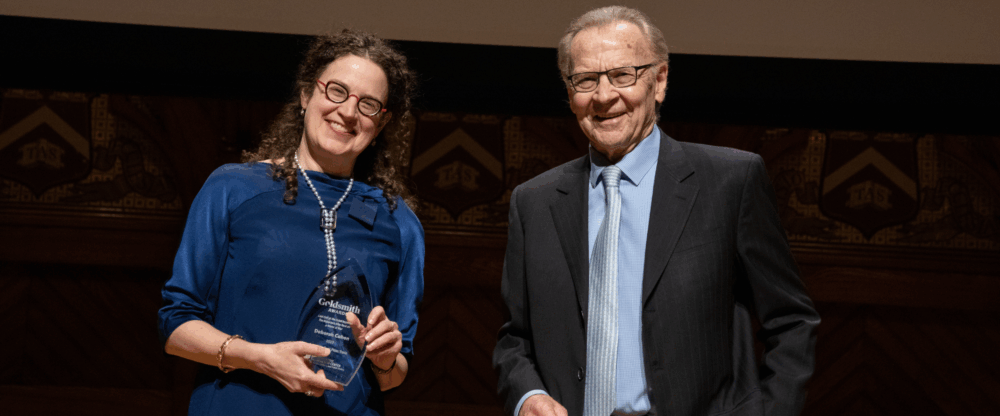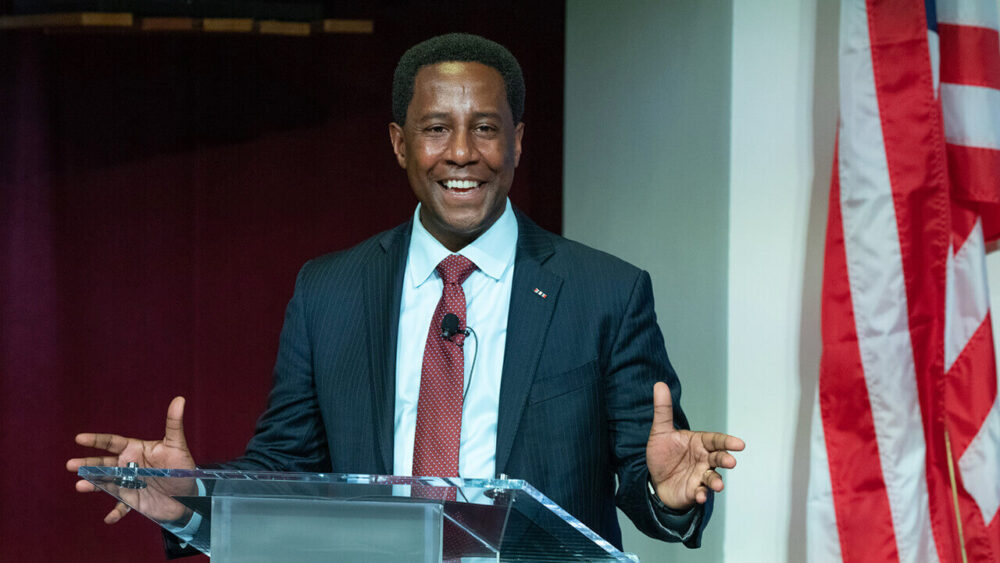
Nominations open for the 2026 Goldsmith Awards
Newsletter
It would be ludicrous if it wasn’t so malicious: Fringe websites and social media users dismissed the migrant families who got caught up in skirmishes at the U.S.-Mexican border as “paid crisis actors” taking part in a staged hoax.

That phrase is a dog-whistle reference to the 2012 mass shooting at Sandy Hook Elementary School, where conspiracy mongers derisively described child victims as crisis actors who faked a deadly incident to score political points. The “crisis actor” term has circulated on social media after other high-profile violence in recent years, including the Marjory Stoneman Douglas High School and Pulse Night Club shootings in Florida, and the Boston Marathon bombing. The goal appears to be to sow doubt about basic facts with “false flag” allegations as well as to harass and intimidate opponents and victims — and to fire up allies in the process.
From the Mexican border at San Diego, a Reuters photo of a woman fleeing spewing tear gas canisters on Sunday became fodder for a meme pointing out purportedly suspicious anomalies in the background, including journalists wearing gas masks, as evidence of the “hoax.” (Journalists routinely wear protective gear in such potential confrontations.)

Twitter user @bahamamills said, “What we are seeing are simply paid crisis actors and the left are falling for it like BREAKING NEWS on @CNN.” That was retweeted more than 400 times. The claim gained traction even though journalists were on the ground alongside the migrants on Sunday, witnessing and capturing the tense border showdown in photos and video. The far-right news site The Gateway Pundit’s headline declared: “Hoaxed: The ‘Illegal Alien Mom with Barefoot Kids’ Photo was a Setup – Another Staged #FakeNews Production” (22.1K Facebook shares).
The hoax narrative spread fast. An article on the right-wing Daily Wire news site asking whether the confrontation was staged circulated on Facebook. The article cited tweets speculating about details in the photo.
The rapid spread of these stories involved multiple social media platforms. Tweets discussing the claim numbered in the thousands, with some of them receiving hundreds or thousands of retweets each. YouTube commentators created video reports such as one from Lisa Haven, who has a news channel with more than 376K subscribers. Her video is titled: “LIES Everywhere: Migrants Slam the Border, Fake Pictures, Fake Narratives…Bombshell!” The video received more than 81K views and gained 1.3K comments by Friday morning.

Other bare-bones videos dissected the purportedly staged photo, including Martin Brodel (2.6K views), ramzpaul (10.4K views), and An0maly – News Analysis & Hip-hop (41.1K views). Conservative pages on Facebook also released videos that racked up large view counts. This Daily Caller video got 589K views and this video shared by Comedian Bryan Dey got 226K views. Several video commentators complained that mainstream news coverage left out the fact that some migrants threw rocks and other projectiles at U.S. border agents, prompting the tear gas. Many of these videos have comment streams that serve as enraged echo chambers for viewers.
Chatter on alternative social media platforms has also been busy, although this is more difficult to quantify. A 4chan thread received over 170 replies, and a Reddit post received more than 40 upvotes. Conversation has also occurred on Discord.
Within 48 hours, a meme competition was launched to portray the running family in ways that demonize illegal immigration. The account has since been suspended. Prior to the suspension, nasty images poured in — including one from the parody Twitter account of a non-existent Georgia congressman @RepStevenSmith, dropping the migrant family into a Ku Klux Klan image.

Beyond the crisis actor claim, there were other examples of mis- and disinformation that swirled across social media in the midst of the border clash:
Twitter users complained that some migrants in Sunday’s melee had chanted “Si se puede,” Spanish for “Yes, it can be done,” and claimed that to be an order from former President Barack Obama, whose campaign slogan was “Yes we can.” In fact, “Si se puede” dates back at least to Cesar Chavez’s farmworker movement in the 1960s and ‘70s, and has long been a frequent chant at demonstrations across Latin America.
Some sought to underscore the story line that an “invasion” was looming: A “newsflash” on the far-right site Natural News said 90 percent of the migrant caravan members amassed at the border were “military-aged males.” (The U.S. Department of Homeland Security says about half of those in the caravan are single men, who include 270 with “criminal histories, including known gang membership.”) A meme claimed that President Trump had temporarily closed the entire border; while the president did threaten to close the complete border, in fact authorities only closed the San Ysidro border in San Diego for a few hours.
For it’s part, the anti-Trump left also fell into some angry hyperbole: Some complained that U.S. border agents had used a powerful tear gas to attack defenseless migrants. In fact, anti-riot tear gas was used numerous times on the border during the Obama administration without an outcry.
Conspiracy theories alleging hoaxes and false flag tactics are certainly not new. Such claims echoed after the 9-11 terror attacks in the United States. But the huge difference is the role social media and fragmented, polarized websites have played over the last decade in hyping the suspicions of and radicalizing participants.
Conspiratorial allegations have come from the left, too. After the shooting of five police officers in Dallas in 2016 by a man who declared himself angry over blacks being shot by police, some speculated on Twitter about a possible false flag operation, saying without evidence that the government may have been behind the shootings to undermine the Black Lives Matter movement.
The crisis actor claim leveled against the migrants was nurtured by two months of increasing social media agitation and demeaning memes targeting the members of the caravan, from its emergence in Honduras. These conversations contributed to a narrative of impending invasion, complete with a red-starred tank, being met by right-wing citizen militias deploying to the U.S.-Mexico border to support U.S. soldiers sent by President Trump. Some social media users exaggerated the size of the caravan (alleging it to be 40,000 strong), and the threat it posed (gang members).
The crisis actor accusation often serves to dehumanize victims and deflate the gravity of real-world tragedies. In that sense, it echoes the memes and other forms of disinformation that the Information Disorder Lab has encountered since its launch.
Click to subscribe and get the ID Lab’s IDWire directly to your inbox.


Center News

Center News